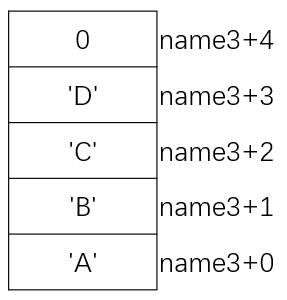:::info 字符串:Array-Style Strings and string class
- 数组风格的字符串
- String class :::
Array-style strings
- An array-style string (null-terminated strings/arrays of characters) is a series of characters stored in bytes in memory.
- This kind of strings can be declared as follows
字符串本身就是数组,将字符存到数组中,就形成了字符串。
// initchar.cppchar rabbit[16] = {'P', 'e', 't', 'e', 'r'}; // 数组的类型为char,元素个数为16个char bad_pig[9] = {'P', 'e', 'p', 'p', 'a', ' ', 'P', 'i', 'g’}; //a bad one! 正好9个元素,对待一个数组字符串时,字符串的结束标志就是0,如果没有,该字符串数组时不会停止的,直到找到0。char good_pig[10] = {'P', 'e', 'p', 'p', 'a', ' ', 'P', 'i', 'g', '\0'};
// Returns the number of characters, the first NULL will not be included.// 返回字符串数组的长度size_t strlen( const char *str );
字符串长度 vs. 字符串数组的长度
char rabbit[16] = {'P', 'e', 't', 'e', 'r'}; // 数组的类型为char,元素个数为16个
- 字符串数组的长度16
- 字符串长度为为5
```cppchar name[10] = {'Y', 'u', '\0', 'S', '.', '0'};cout << strlen(name) << endl;// 字符串长度为2,
include
include
using namespace std;
int main() { char rabbit[16] = {‘P’, ‘e’, ‘t’, ‘e’, ‘r’}; cout << “String length is “ << strlen(rabbit) << endl; for(int i = 0; i < 16; i++) cout << i << “:” << +rabbit[i] << “(“ << rabbit[i] << “)” << endl;
char bad_pig[9] = {'P', 'e', 'p', 'p', 'a', ' ', 'P', 'i', 'g'};char good_pig[10] = {'P', 'e', 'p', 'p', 'a', ' ', 'P', 'i', 'g', '\0'};cout << "Rabbit is (" << rabbit << ")" << endl;cout << "Pig's bad name is (" << bad_pig << ")" << endl;cout << "Pig's good name is (" << good_pig << ")" << endl;char name[10] = {'Y', 'u', '\0', 'S', '.', '0'};cout << strlen(name) << endl;return 0;
}
```
// result
String length is 5 // 因为r后面是0,所以停止,否则字符串数组继续索引,直到遇到0
0:80(P)
1:101(e)
2:116(t)
3:101(e)
4:114(r)
5:0()
6:0()
7:0()
8:0()
9:0()
10:0()
11:0()
12:0()
13:0()
14:0()
15:0()
Rabbit is (Peter)
Pig's bad name is (Peppa PigPeter) // 此时,就能看出,数组越界了,也说明了rabbit字符串数组是存储再bad_pig的后面,
Pig's good name is (Peppa Pig)
2
字符串数组最后一定要加个0.
String literals
- It isn’t convenient to initial a string character by character.
- String literals can help. ```cpp char name1[] = “Southern University of Science and Technology”; char name2[] = “Southern University of “ “Science and Technology”; // 2 == 1 char name3[] = “ABCD”; //how many bytes for the array? 字符串长度为4, 数组长度为5

```cpp
const wchar_t[] s5 = L"ABCD"; //
const char16_t[] s9 = u"ABCD"; //since C++11
const char32_t[] s6 = U"ABCD"; //since C++11
字符串操作
Copy
char* strcpy( char* dest, const char* src ); // 内存拷贝:src -> dest
该API并没有说明src 和 dest数组有多长,那么,拷贝的时候拷贝多少元素呢?src有多少元素就拷贝多少。那么为题来了,如果dest的数组空间不够,那么就会拷贝溢出。
Safer one:
char *strncpy(char *dest, const char *src, size_t count); // 最多拷贝count个元素,避免数组越界, // 可以将count设置为src 和 dest长度的最小值Concatenate: appends a copy of src to dest
将两个字符串合并成一个
char *strcat( char *dest, const char *src ); // 将src拷贝到dest的后面,也面临着数组越界的风险, // 也有更为安全的API -> `strncat`Compare
字符串的比较
int strcmp( const char *lhs, const char *rhs );```cpp
include
include
using namespace std;
int main() { char str1[] = “Hello, \0CPP”; char str2[] = “SUSTech”; char result[128];
for(int i = 0; i < 16; i++)
cout << i << ":" << +str1[i] << "(" << str1[i] << ")" << endl;
strcpy(result, str1);
cout << "Result = " << result << endl;
strcat(result, str2);
cout << "Result = " << result << endl;
cout << "strcmp() = " << strcmp(str1, str2) << endl;
//strcat(str1, str2); //danger operation!
//cout << "str1 = " << str1 << endl;
}
```
// results
0:72(H)
1:101(e)
2:108(l)
3:108(l)
4:111(o)
5:44(,)
6:32( )
7:0()
8:67(C)
9:80(P)
10:80(P)
11:0()
12:12()
13:0())
13:0()
14:0()
15:0()
Result = Hello,
Result = Hello, SUSTech
strcmp() = -11 // (H-S, 72-83)
string class
- Null-terminated strings are easy to be out of bound, and to cause problems.
- string class provides functions to manipulate and examinate strings.
之前的string数组不会进行边界检查,一不小心就会出错,数组越界等各种问题;string类会大幅度降低出错概率
std::string str1 = "Hello";
std::string str2 = "SUSTech";
std::string result = str1 + ", " + str2;
#include <iostream>
#include <string>
using namespace std;
int main()
{
std::string str1 = "Hello";
std::string str2 = "SUSTech";
std::string result = str1 + ", " + str2;
cout << "result = " + result << endl;
cout << "The length is " << result.length() << endl;
cout << "str1 < str2 is " << (str1 < str2) << endl;
return 0;
}
// results
result = Hello, SUSTech
The length is 14
str1 < str2 is 1
// Different types of strings
std::string
std::wstring
std::u8string //(C++20)
std::u16string //(C++11)
std::u32string //(C++11)

